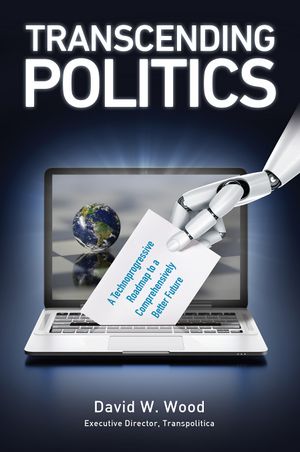Chapter 4. "Work and purpose"
Chapter 4. "Work and purpose" is the title of the fourth Chapter in the book Transcending Politics by David Wood.

"The robots are coming. In the worst case, sometime later this century, they might run amok and kill us all. That’s the Terminator scenario. It’s not as absurd as you might think. After all, software, which is the animating power behind modern robots, has a history of going wrong. And super-complex software has a risk of going super-wrong.
We’ll come back to the Terminator scenario in later chapters. For now, however, there’s a shorter-term worry to consider. Instead of robots that might kill humans, we have to think about robots that might kill jobs. Robots may become so good at doing the kinds of work that we humans currently get paid to do, that our present jobs might disappear. The short label for this process is “technological unemployment”.
Technological unemployment is a prospect which causes a lot of alarm. But the Transpolitica vision sees a larger opportunity in the rise of robots. Society should be able to welcome the disappearance of the need for people to undertake work that has often been tiresome, tedious, dangerous, or dispiriting. With the help of robots, we should all be able to spend much more of our time in activities that express and enhance our humanity."
- - David Wood, Executive Director, Transpolitica[1]
The rise of the robots
Robots have been killing jobs, on noteworthy scale, since the first Industrial Revolution.
Automation accelerates
As recently as 2004, economists Frank Levy of MIT and Richard Murnane of Harvard confidently included the task of “driving a truck” in a list of occupations for which “computerization should have little effect on the percentage of the work force engaged in these tasks”.
Machine learning powers ahead
Machine learning has existed, in various forms, almost as long as standard artificial intelligence. But it's only in the present decade that it has achieved significant results - aided by much more powerful computers, and larger datasets, than were previously available.
80% job transformation?
As I mentioned, machine learning heralds a second era of artificial intelligence - one in which software plays a big part in determining the rules by which it operates.
Limits to retraining
Here's one response that is often heard to the threat of technological unemployment. Don't worry; humans will be able to retrain, moving to a new profession. The retraining may take some time, resulting, perhaps, in a temporary reduction in early earnings.
Robots and humans in work partnership?
Here's a second response that is often raised to the threat of technological unemployment. When costs reduce for part of a task (due to automation), companies can provide their products and services more cheaply, reaching lower price points than before.
Three possible futures for automation
It’s time to take a different perspective on the main trend discussed in this chapter. Let's start with observation that automation is likely to generate large amounts of additional profits. There are three views on what is expected to happen with these profits...
Citizen’s income Qs & As
Thanks to automation and the general prosperity arising from it, society has more money to cover, if it chooses, the cost when people ...Ten Questions
The pace of change
Q10: How urgent are these discussions? Isn’t significant technological unemployment still many generations into the future?
A: The pace of change is, notoriously, hard to predict. Roy Amara, the past president of the Institute of the Future, observe that[2]:
"We tend to overestimate the effect of technology in the short run and underestimate the effect in the long run."
External links
References
- ↑ https://transpolitica.org/
- ↑ “Roy Amara, forecaster, RIP” http://boingboing.net/2008/01/03/roy-amara-forecaster.html